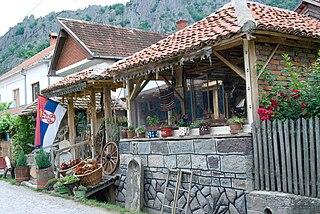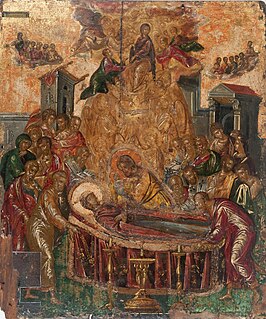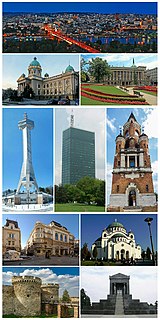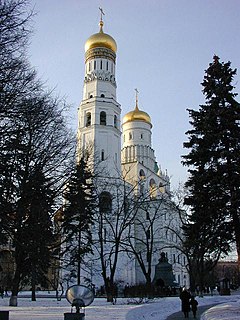
Sremski Karlovci is a town and municipality located in the South Bačka District of the autonomous province of Vojvodina, Serbia. It is situated on the bank of the river Danube, 8 kilometres from Novi Sad. According to the 2011 census results, it has a population of 8,750 inhabitants. The town has traditionally been known as the seat of the Serbian Orthodox Church in the Habsburg Monarchy, as well as political and cultural capital of Serbian Vojvodina after the May Assembly and during the Revolution in 1848.

Inđija is a town and a municipality located in the Srem District of the autonomous province of Vojvodina, Serbia. As of 2011, the town has total population of 26,025, while the municipality has 47,433 inhabitants. It is located in the geographical region of Syrmia.

Lazarevac is a municipality of the city of Belgrade. As of 2011, the town has a total population of 25,526 inhabitants, while the municipal area has a total of 58,622 inhabitants.
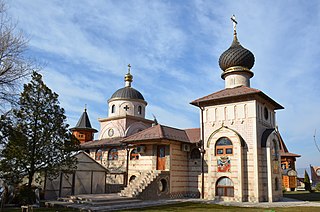
Paraćin is a town and municipality located in the Pomoravlje District of central Serbia. It is located in the valley of the Velika Morava river, north of Kruševac and southeast of Kragujevac. In 2011 the town had a population of 24,573. It also had a civil airport.

Sombor is a city and the administrative center of the West Bačka District in the autonomous province of Vojvodina, Serbia. The city has a total population of 47,623, while its administrative area has 85,903 inhabitants.

Bela Palanka is a town and municipality located in the Pirot District of southeastern Serbia. According to the 2011 census, the population of the town is 8,143, and the population of the municipality is 12,126. In ancient times, the town was known as Remesiana. The name Bela Palanka means 'white town'.

Bački Petrovac is a town and municipality located in the South Bačka District of the autonomous province of Vojvodina, Serbia. The town has a population of 6,063, while Bački Petrovac municipality has 13,302 inhabitants.
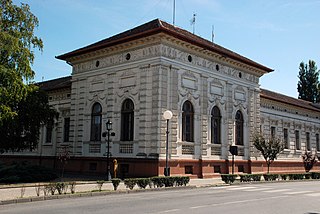
Srbobran is a town and municipality located in the South Bačka District of the autonomous province of Vojvodina, Serbia. The town is located on the north bank of the Danube-Tisa-Danube canal. The town has a population of 12,009, and the municipality of 16,317.

Žitorađa is a village and municipality located in the Toplica District of the southern Serbia. The municipality includes 30 settlements. According to the 2011 census, the population of the municipality is 16,368 inhabitants.

Loznica is a city located in the Mačva District of western Serbia. It lies on the right bank of the Drina river. In 2011 the city had a total population of 19,572, while the administrative area had a population of 79,327.

Topola is a town and municipality located in the Šumadija District of central Serbia. It was the place where Karađorđe, a Serbian revolutionary, was chosen as the leader of the First Serbian Uprising against the Ottoman Empire in 1804. The local St. George Church is the burial place of the Ducal and Royal Family of Serbia and Yugoslavia.
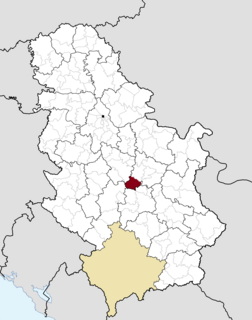
Rekovac is a village and municipality located in the Pomoravlje District of central Serbia. According to 2011 census, the population of the village is 1,587, while population of the municipality is 10,971. Rekovac is the center of small geographical region called Levač.
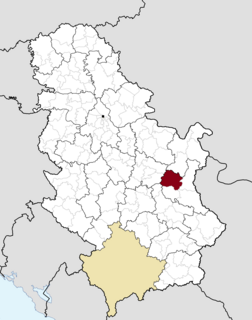
Boljevac is a town and municipality located in the Zaječar District of the eastern Serbia. According to 2011 census, the population of the town is 3,332, while population of the municipality is 12,865.

Gadžin Han is a village and municipality located in the Nišava District of the southern Serbia. According to 2011 census, the municipality has 8,389 inhabitants.

Crna Trava is a village and municipality located in the Jablanica District of southern Serbia. According to 2011 census, the population of the village is 434 inhabitants, while population of the municipality is 1,663. This is the smallest by population and poorest municipality in Serbia.

Boljevci is a suburban settlement of Belgrade, the capital of Serbia. It is located in Belgrade's municipality of Surčin.

Zuce is a suburban settlement of Belgrade, the capital of Serbia. It is located in Belgrade's municipality of Voždovac.

Masurovci is a village in the municipality of Babušnica, Serbia. According to the 2002 census, the village has a population of 28 people.

Beloinje is a village in Serbia, in the municipality of Svrljig in Nisava district. According to the census of 2002, there were 343 people.





